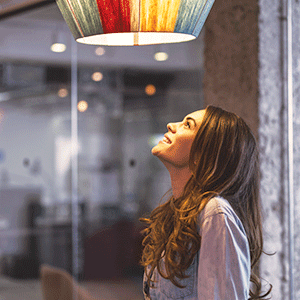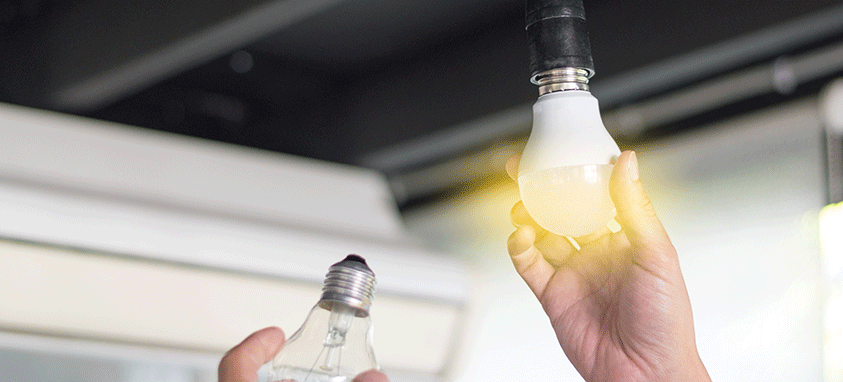LEDs save time, money and manpower
The right lighting can change everything. Event strategist Kate Patay calls illumination “one of the most dramatic and cost-effective ways to transform an event space.” That is why a lighting designer is always at the top of her checklist. “Lighting sets the tone of the room, creates ambience, focuses the attention of the attendees and is a great branding tool,” she says.
Long gone are the days of conventional, incandescent lighting, where an arsenal of light sets, instruments, gels and loads of manpower was required. LED lighting shrunk cases of equipment to a fraction of its original size, but requires a practiced eye to create something that adds to the event, rather than distracts from it.
Not long ago, conventional lighting was event specialists’ first choice for adding drama to a room, but since the introduction of LED lighting, traditional, incandescent fixtures have fallen by the wayside. Smart Meetings spoke to two representatives at Clarity Experiences, Lighting Designer Chris Dumapias and Vice President of Customer Development Gary Lagastee, to learn the tricks for getting the most out of today’s LED lighting set.
Reduce Manpower
With a traditional Lekolite instrument, when stage lighting is slightly off color, a change in its intensity—meaning a drop in the temperature of your lighting—might be required, which involves adding or subtracting a gel to adjust the colors and temperature. You might need to change the focus of your lighting, as well.
Manual changes can be time-consuming. In the heat of an event, constant adjustments need to be made, which requires a lot of physical labor in a short time. With LED lighting, manpower can be cut down to one-third as the control box has all you need, such as easy access to adjust focus, color and intensity at the touch of a dial.
Large event spaces aren’t the only ones used for events and meetings. Sometimes, an outside space or smaller office space is needed. “In cases such as these, power is limited,” Dumapias said. Conventional lighting consumes a lot of power—more than you can realistically use in settings such as these. Lower power consumption of LEDs allows more lights to be used on a single circuit, thus enabling greater flexibility in situations with limited space and sources of power.
LEDs also allow you to make adjustments as needed. “With conventional lighting, you set it in advance, and that’s your show, Lagastee said. “You have very limited ability to make change things on the fly.” He recalled a recent show that had unengaged attendees. So, the host asked if he could leave the stage and walk around the room while being followed by an intelligent LED light rig. He thereby was able to make a quick change that would not have been possible with conventional lighting.
Save Time and Money
The typical setup includes a lot of cables, hanging lights and one power line for each light fixture being used. “With LED lighting, there are minimal cables, minimal hands-on action and way more function—and it gets done in probably one-eighth of the time.”
With the reduction in power consumption that LED lighting brings, it follows that there is also lower cost. Along with the monetary savings, planners save time. Much time can be spent on fixing lighting errors during events, and using LED lighting and instruments ensures less errors.
Time spent trying to correct lighting mistakes can take away from time for other aspects of the event. With the adaptability of LED lighting, event professionals can allocate their time to making incredible experiences for their attendees.
Bright Ideas
David Merrell, CEO and creative director at AOO Events in Los Angeles, has some rules of light he shares with event professionals looking to brighten things up.
Put overhead lighting on a dimmer and bring it down to about 50 percent brightness. Shine direct light on buffets and bars so people can see the food and read the menu. Consider battery-operated up-lighting on the perimeter to add interest to the room.
Merrell says dark is your friend if there are things you want to hide. “Selective visual lighting takes eyes away from things you don’t want to see and redirects them to the stuff you want them to see.”
Human-Centric Lighting
 Light affects human beings in profound ways. It affects our level of productivity, sleep cycles and even our mood, as in the case of those who experience seasonal affective disorder. Human-centric, or biorhythmic, lighting can increase productivity, improve concentration and encourage healthier sleep patterns.
Light affects human beings in profound ways. It affects our level of productivity, sleep cycles and even our mood, as in the case of those who experience seasonal affective disorder. Human-centric, or biorhythmic, lighting can increase productivity, improve concentration and encourage healthier sleep patterns.
Being exposed to blue light for long periods of time can be harmful, as it can disrupt our normal sleep cycle. At day’s end, when natural light tends to deliver a warmer color but you’re still exposed to blue light, your brain can be tricked into thinking that it’s still daytime and that you should remain awake. Programmed, biorhythmic lighting simulates the transition of light that the sun emits throughout the day, ranging from a clear blue to a warm, orange-like hue, leaving attendees in a stimulated, productive mood.




